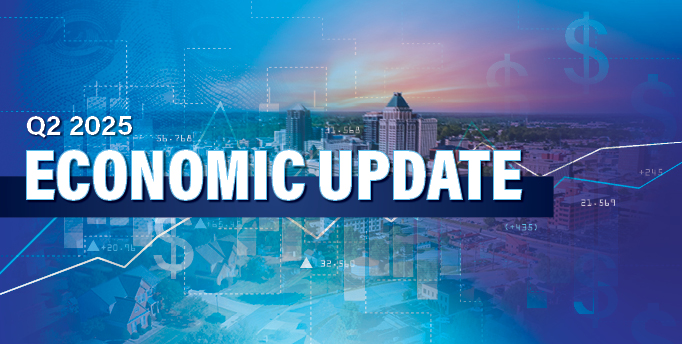The economy bounced back in the second quarter, shrugging off tariff activity, tensions in the Middle East, recession headlines and, to a degree, interest rates. Both residential home sales and commercial real estate (CRE) transaction volume performed on par with the previous quarter. Mortgage rates certainly dampened the residential market, but a blossoming of inventory and further price moderation created a buyer-friendly field. CRE market participants remained engaged, as the asset class fundamentals nurtured the emerging new investment cycle. The Federal Reserve (the Fed) is on watch this summer and signaling a willingness to act, should the full tariff implementation in July undermine the existing strong economy.
Residential Real Estate
The Q2 spring housing market didn’t flower fully as hoped. Total Home Sales were virtually flat from the previous quarter, despite moderate improvement in New Home Sales. Many buyers were inhibited by the 30-year fixed-rate mortgage, which has hovered around 6.8% since mid-April. Rates reflected a widening spread over the 10-year treasury yield*, which sprung up during the quarter due to the upcoming deficit-enlarging federal budget and uncertain path of inflation.
However, those stepping into the market were welcomed by a profusion of positive factors. "Consistent job gains and rising wages are modestly helping the housing market," said National Association of REALTORS® Chief Economist Lawrence Yun. Many market’s inventories were back to pre-pandemic levels and homes for sale nationwide in May were up over 30% from last year. The FHFA House Price Index is expected to settle around 2.9% in Q2, barely above inflation.
Builders, whose confidence waned over the year due to immigration and tariff policies, toiled to produce better market balance. They are expected to slow annual Single Family Starts by more than 8% in Q2, according to the Mortgage Bankers Association (MBA). The percentage of builders offering price concessions jumped 8 points in just the last three months, and about a third of the metro areas in Q1 saw declining new home prices. These moves cultivated a historically uncharacteristic situation: new home prices since March have been lower than existing home prices, as the chart below shows. Unsurprisingly, buyer sentiment rose. Not only are buyers facing a less frenzied atmosphere, but they may get a new home for the cost of an older one.

Commercial Real Estate
The CRE industry in Q2 defied the prevailing interest rates and uncertain economic environment. According to CoStar, transaction volume for the four major asset groups was $60.1B, virtually even with Q1 volume and representing a 24% surge in 12-month sales volume growth. Price discovery momentum certainly played a role; the CCRSI dropped for the third month in May. The star for the quarter was the Office sector; deal activity climbed over 30% from Q1. Cap rates reflected the steady nature of investor sentiment, while the rate for Industrial notably crept down a notch."
Delinquency rates worsened in Q1, although there was “continued appetite for real estate investment across key investor groups,” according to the MBA. Banks spent 2024 cleaning up their CRE portfolios, allowing flexibility in extensions of worthy borrowers in 2025 and beyond. This may account for why distress transactions remained low.
CoStar data reveals firm fundamentals across the asset classes. The Apartment sector’s attractiveness was strengthened by positive absorption, steadying vacancies and rent growth. Retail was solid as new tenants stepped in to fill an unusual amount of vacated space, although a softening economy weighed on rents. “The office recovery is at last underway….” according to one headline, due to renewed leasing activity in New York and hope for other Central Business Districts. However, prolonged underperforming Office demand pulled vacancies up to 14.1% and suppressed rent growth again. Industrial’s speculative inventory and some initial impact from tariff-hobbled trade led to a soft quarter. Although vacancies swung up to 7.3% and rent growth inched below 2%, concern was muted by announcements of future manufacturing reshoring and the durability of ecommerce.
A Glance Forward
As the Fed’s Chairman Powell recently remarked, “It’s hard for anyone to know where the economy is going.” Indeed, forecasters are not in alignment for Q3 GDP growth, as exemplified by Fannie Mae’s and the MBA’s projections (1.7% and .1% respectively). But there is a consensus for a 0.5% inflation uptick, as the full impact of tariffs starts this summer. The Fed still shows two rate cuts for the year, likely to start in September after the path of inflation and the labor market are clearer.
The residential market may perk up slightly in Q3, as solid starts and subdued price growth encourage those in the market. Also, buyers may be acclimating to mortgage rates that may again sway around 6.8%. Total Homes Sales are anticipated to jump almost 8% compared to a year ago. But workers’ job security worries, as well as builders’ costs and inventory concerns, have curbed the quarter’s outlook.
Many industry forecasters expect CRE’s Q2 momentum to carry into Q3. CBRE shares those sentiments, as long as the 10-year treasury yield stays below 5% (after much seesawing, it ended the quarter where it started – at approximately 4.2%). The expected economic slowdown could weaken some asset class fundamentals, and an expansive deficit could provoke more volatility and higher bond yields. On the other hand, the federal government’s new proposed budget has CRE-supportive tax provisions for manufacturing and opportunity zones.
While a cloudy summer is possible, developments that bring market clarity could create a more fertile environment for the rest of the year.
*Board of Governors of the Federal Reserve System (US), Market Yield on U.S. Treasury Securities at 10-Year Constant Maturity, Quoted on an Investment Basis [DGS10], retrieved from FRED, Federal Reserve Bank of St. Louis; https://fred.stlouisfed.org/series/DGS10, July 2, 2025.




